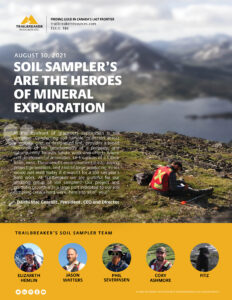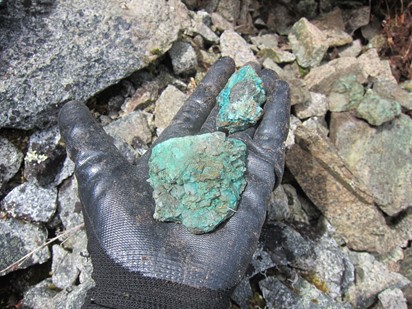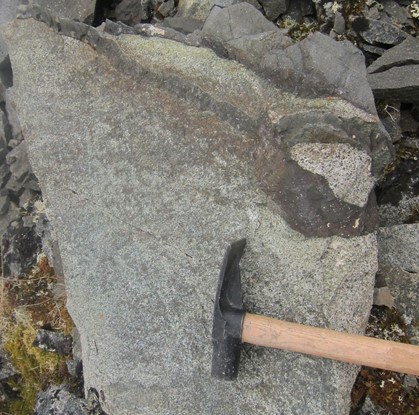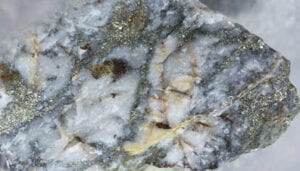Soil Sampler’s are the Heroe’s of Mineral Exploration


We’ve been busy! The Phase 1 Exploration Program at Atsutla was incredibly effective at collecting a vast quantity of data during a short time period. We are pleased to share some rock sample photos of mineralized zones from our 100%-owned Atsutla Gold Project in British Columbia. Trailbreaker Resources Ltd. (TBK.V) is mapping and focusing on these newly recognized gold mineralized hot spots.
The select photos are from areas we are actively chasing at Atsutla, as part of our focus on gold exploration. Additionally, there are a lot of strong indicators for copper mineralization as well.
Download PDF: Geochemistry at Atsutla Gold Project
By Natasha Morris, Project Geologist

Malachite and azurite showings on quartz vein grab sample- Atsutla Property
The process of creating ore deposits requires many factors to line up. A few of these factors include, heat, pressure, fluid migration, and chemistry. That said, certain tectonic settings are more prone to these factors than others, most of which at some point in time had similar systems to volcano formation.
Volcanoes are eloquently linked with heat, pressure, and fluid creation, making that part pretty easy to distinguish; however it gets complicated. The chemistry and more specifically geochemistry of the fluids needs just the right ingredients, and cooking temperature/pressure…to create ore deposits.
Most systems need silica-rich and metal-rich fluids. The silica sources for the fluids are from the coarse crystalline roots of the volcano, intrusive granite like underworkings; and the metal-rich fluids can also be sourced from the intrusives, but are more so affiliated with more lower-silica byproducts of volcanoes, referred to as mafic intrusions and eruptions. To get both of these in a fluid takes a long time…even on the geological scale!
Our Atsutla Gold Project is situated on an old paleo-arc, convergent tectonic setting, with evidence of volcanic activity occurring as old as the Mesozoic to the Eocene, essentially over a ~150 million year period. Check out the photos below for examples of where we see evidence of mafic intrusions in the silica-rich Christmas Creek batholith.
For more information on our Atsutla Gold Project please check out our website:
https://www.trailbreakerresources.com/atsutla-gold-project/

Christmas Creek batholith showcasing mafic dyke invasion with entrained batholith host clast – Atsutla Property

Boulders and grab samples showing mafic clasts with malachite staining- Atsutla Property
A legal disclaimer for Trailbreaker Resources can be found here: Disclaimer
Why do prospectors often look for quartz when searching for gold?
By Natasha Morris, Project Geologist, Trailbreaker Resources
Although gold can be found associated with a number of minerals and other metals, quartz seems to be the most commonly viewed gold exploration mineral. Quartz in general has a very high hardness (~7 on Mohs mineral hardness scale), meaning it’s resistant to weathering and
does not break down as quickly as other minerals. This makes quartz in general a great host for gold and ore preservation.

Quartz sulphide vein sample from Trailbreaker’s Skelly Property in British Columbia
In terms of geochemistry, quartz is composed of silica, and prior to the quartz crystallizing it is entrained in fluid. These fluids percolate and collect in whatever conduits they can in the rock, creating veins and fracture fills. Fluids that are saturated with silica and also contain gold, can form at many different temperature and pressure conditions, therefore a whole range of deposit types showcase gold and quartz intrinsically linked.
Unfortunately, finding quartz- which is part of the grouping of the most common minerals found on earth…doesn’t necessarily mean you will find gold! Understanding the bigger picture and plumbing systems of how and where the silica fluids came from, is the biggest factor in assessing how much gold is in your quartz.
To learn more about what the Trailbreaker team looks for when prospecting for gold deposits, please check out our website: https://www.trailbreakerresources.com/
About Trailbreaker Resources
Trailbreaker Resources Ltd. (TBK.V) (“Trailbreaker” or “the Company”) is a project generator focused primarily on mining-friendly British Columbia and Yukon Territory, Canada. We are committed to continuous exploration and research, allowing us to maintain a portfolio of quality mineral properties which in turn provides value for our shareholders. The company has an experienced management team with a proven track record as project generators and developers throughout the Yukon Territory, British Columbia, Alaska and Nevada.